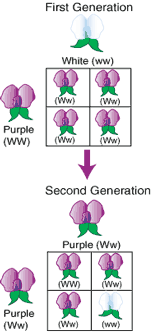
|
Why was Mendel Successful? Mendel's choice of the pea plant for his experiments was not original. However, he was successful in formulating the fundamental principles of heredity - where others had failed - because of his approach to the problem. First, he tested a very specific hypothesis in a series of logical experiments. He planned his experiments carefully and imaginatively, choosing for study only clear-cut, measurable hereditary differences. Second, he studied the offspring of not only the first generation but also the second and subsequent generations. Third, and most important, he counted the offspring and then analyzed the results mathematically. Even though his mathematics was simple, the idea that a biological problem could be studied quantitatively was startlingly new. Finally, he organized his data in such a way that his results could be evaluated simply and objectively. The experiments themselves were described so clearly that they could be repeated and checked by other scientists, as eventually they were.
Genes: Characteristics were determined by genes, or units of inheritance, which determined the characteristics displayed in an individual. The particular form of the gene is an allele, e.g., the allele for white flower color or the allele for purple flower color. An individual inherited a pair of genes, one from each parent. When an allele was dominant, the form of the characteristic it determined was always displayed. When an allele was recessive, the form of the characteristic it determined was displayed only when both alleles were the same. Both alleles could be passed on to offspring without being altered in the process. If a recessive form was not displayed in one generation, it could be displayed unaltered in a subsequent generation.
Genotype: The genetic makeup of the organism contains a matched pair of alleles for each trait. Each allele of the matched pair exists independently and as a discrete unit, whether it is dominant (always expressed like the purple flower color) or recessive (not expressed like the white flower color in the presence of the dominant allele for purple color).
Phenotype: The outward appearance and other observable characteristics of the organism, such as the white flower color when both alleles are recessive or purple flowers when one or both of the alleles is dominant.
Segregation: Every individual carries a pair of factors for each trait. During the formation of gametes, the individual members of the pair separate and the sperm or egg cell receives only one member of the pair. This is Mendel's first law or the principle of segregation.
Assortment: When sperm and egg are formed, the alleles for one trait separate independently of the alleles for other traits. This is Mendel's second law or the principle of independent assortment.
Chromosomes: The large molecules that carry the DNA of the genes. Many genes are carried on each chromosome, and, therefore, are linked as a single unit and inherited together. The 30,000-50,000 genes in the human genotype are carried on 23 pairs of chromosomes (a person has 2 of each of the 23 chromosomes).
Crossing-over: Before cell division starts, the chromosomes in the nucleus duplicate with the result that each chromosome consists of a pair of matching sister chromatids. Early in meiosis (the process of cell division that produces gametes), the homologous chromosomes from the male and female parents line up close to each other and chromatids may exchange segments. When they separate, it is possible that each of the four chromatids will be different.
 |
- Point mutation: Any of 70 known mutations in the gene for phenyalanine hydroxylase that inactivates this enzyme, will prevent the conversion of phenylalanine to tyrosine and result in phenylketonuria (PKU), a debilitating disease. Newborn babies are routinely tested in the United States.
- Duplication: If the chromatids fail to exchange the same size segments during crossing-over, it is possible that the chromatid that receives the larger segment may then contain a duplicate copy of one of its genes. The b-hemoglobin gene is thought to have originated in this way.
Also: Phenylketonuria